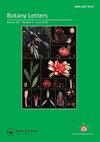Origin of Hawaiian ferns of the genus Ctenitis (Dryopteridaceae)
IF 1.3
4区 生物学
Q3 PLANT SCIENCES
引用次数: 0
Abstract
ABSTRACT The Hawaiian Islands are an emblematic field to study evolution, with their very high rates of endemism and spectacular cases of insular speciation. Nevertheless, many Hawaiian lineages still deserve investigation, such as in the fern lineage. In this study, we address the question of the origin of the fern genus Ctenitis, which is present in the archipelago with two endemic species, Ctenitis squamigera and C. latifrons. Using a taxonomic sampling covering the pantropical distribution of the genus and three chloroplast DNA regions, we provide evidence that the genus in the Hawaiian Islands originated from a single long-distance dispersal from the Neotropics. This area is less represented than Asia and the South Pacific in the origin of Hawaiian ferns, but a Neotropical origin may be explained by the transportation of spores by tropical storms originating near Central America. Furthermore, the colonization of the Hawaiian Islands is estimated to have occurred between 4 [9–2] and 3 [7–1] mya. This timing is consistent with the ages of all main and extant islands of the archipelago, which already provided habitats for the establishment of the initial Ctenitis colonizer. In turn, this relatively late arrival to the islands and the related potentially low availability of ecological niches may have hampered diversification of the genus beyond the two extant species.鳞毛蕨属夏威夷蕨类植物的起源(鳞毛蕨科)
摘要夏威夷群岛是研究进化的一个象征性领域,具有极高的地方性和惊人的岛屿物种形成案例。尽管如此,许多夏威夷谱系仍然值得研究,例如蕨类谱系。在这项研究中,我们解决了蕨属Ctentis的起源问题,该属与两个特有物种,即鳞片Ctentiss和拉丁C.latifrons一起存在于群岛中。通过对该属的泛热带分布和三个叶绿体DNA区域进行分类采样,我们提供了证据,证明该属在夏威夷群岛起源于新热带的一次远距离传播。在夏威夷蕨类植物的起源方面,该地区的代表性不如亚洲和南太平洋,但新热带蕨类植物的来源可能是源自中美洲附近的热带风暴输送孢子。此外,夏威夷群岛的殖民化估计发生在4[9-2]和3[7-1]米亚之间。这一时间安排与该群岛所有主要和现存岛屿的年龄一致,这些岛屿已经为最初的克氏殖民者的建立提供了栖息地。反过来,这种相对较晚到达岛屿的情况以及相关的潜在生态位低可用性可能阻碍了该属在两个现存物种之外的多样化。
本文章由计算机程序翻译,如有差异,请以英文原文为准。
求助全文
约1分钟内获得全文
求助全文
来源期刊

Botany Letters
Agricultural and Biological Sciences-Plant Science
CiteScore
3.10
自引率
6.70%
发文量
54
期刊介绍:
Botany Letters is an international scientific journal, published by the French Botanical Society (Société botanique de France) in partnership with Taylor & Francis. Botany Letters replaces Acta Botanica Gallica, which was created in 1993, building on over a century of renowned publications by the Société botanique de France.
 求助内容:
求助内容: 应助结果提醒方式:
应助结果提醒方式:


